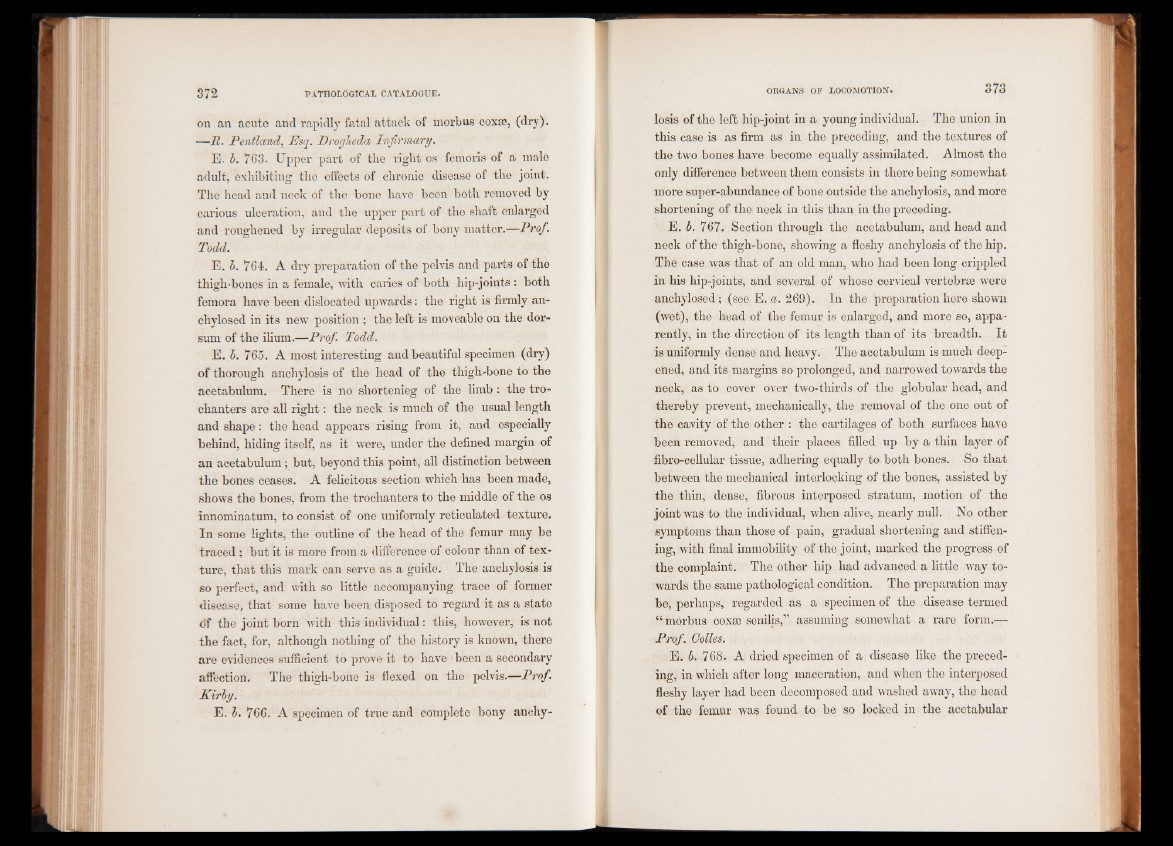
on an acute and rapidly fatal attack of morbus coxae, (dry).
—R. Pentland, Esq. Drogheda Infirmary.
E. h. 763. Upper paid of the right os femoris of a male
adult, exhibiting the effects of chronic disease of the joint.
The head and neck of the bone have been both removed by
carious ulceration, and the upper part of the shaft enlarged
and roughened by irregular deposits of bony matter.—Prof,
Todd.
E. b. 764. A dry preparation of the pelvis and parts of the
thigh-bones in a female, with caries of both hip-joints : both
femora have been dislocated upwards: the right is firmly an-
chylosed in its new position ; the left is moveable on the dorsum
of the ilium.—Prof. Todd.
E. h. 765. A most interesting and beautiful specimen (dry)
of thorough anchylosis of the head of the thigh-bone to the
acetabulum. There is no shortenieg of the limb : the trochanters
are all right: the neck is much of the usual length
and shape: the head appears rising from it, and especially
behind, hiding itself, as it were, under the defined margin of
an acetabulum; but, beyond this point, all distinction between
the bones ceases. A felicitous section which has been made,
shows the bones, from the trochanters to the middle of the os
innominatum, to consist of one uniformly reticulated texture.
In some lights, the outline of the head of the femur may be
traced ; but it is more from a difference of colour than of texture,
that this mark can serve as a guide. The anchylosis is
so perfect, and with so little accompanying trace of former
disease, that some have been disposed to regard it as a state
of the joint born with this individual: this, however, is not
the fact, for, although nothing of the history is known, there
are evidences sufficient to prove it to have been a secondary
affection. The thigh-bone is flexed on the pelvis.—Prof.
Kirby.
E. b. 766. A specimen of true and complete bony anchylosis
of the left hip-joint in a young individual. The union in
this case is as firm as in the preceding, and the textures of
the two bones have become equally assimilated. Almost the
only difference between them consists in there being somewhat
more super-abundance of bone outside the anchylosis, and more
shortening of the neck in this than in the preceding.
E. b. 767. Section through the acetabulum, and head and
neck of the thigh-bone, showing a fleshy anchylosis of the hip.
The case was that of an old man, who had been long crippled
in his hip-joints, and several of whose cervical vertebrae were
anchylosed; (see E. a. 269). In the preparation here shown
(wet), the head of the femur is enlarged, and more so, apparently,
in the direction of its length than of its breadth. It
is uniformly dense and heavy. The acetabulum is much deepened,
and its margins so prolonged, and narrowed towards the
neck, as to cover over two-thirds of the globular head, and
thereby prevent, mechanically, the removal of the one out of
the cavity of the other : the cartilages of both surfaces have
been removed, and their places filled up by a thin layer of
fibro-cellular tissue, adhering equally to both bones. So that
between the mechanical interlocking of the bones, assisted by
the thin, dense, fibrous interposed stratum, motion of the
joint was to the individual, when alive, nearly null. No other
symptoms than those of pain, gradual shortening and stiffening,
with final immobility of the joint, marked the progress of
the complaint. The other hip had advanced a little way towards
the same pathological condition. The preparation may
be, perhaps, regarded as a specimen of the disease termed
“ morbus coxae senilis,” assuming somewhat a rare form.—
Prof . Colies.
E. b. 768. A dried specimen of a disease like the preceding,
in which after long maceration, and when the interposed
fleshy layer had been decomposed and washed away, the head
of the femur was found to be so locked in the acetabular